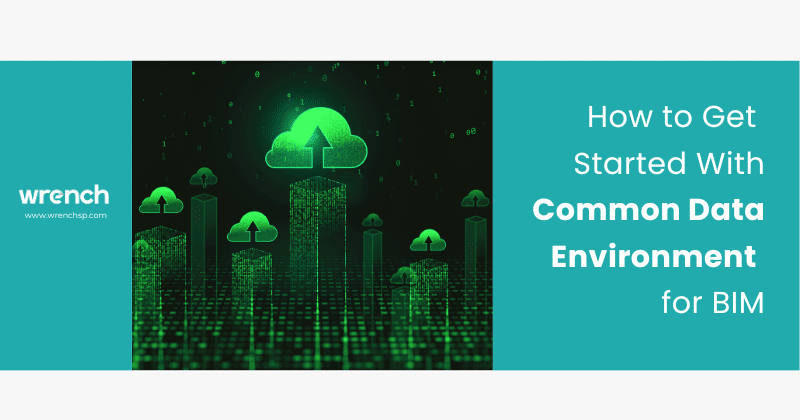- BIM Blog CDE Common Data Environment
- 19 Dec 2023
How to Get Started With Common Data Environment for BIM

What role does a CDE play in construction projects and how does it align with BIM? Let’s find out.
First of all, what is a CDE?
CDE stands for common data environment. It is nothing but an online/digital/cloud-based space to store information. The ‘common’ means shared, as in, a space that is common to all its users. In the context of BIM, and especially BIM for construction, the information in question would be the information about the project, like its drawings, reports, schedules, timesheets, work logs, memos, correspondence, and so on. But a BIM common data environment is more than a data repository; it’s also a working environment for the people collaborating on a project like the project team, stakeholders, and vendors.
One of the key benefits of a CDE is that everybody can access the information they need in real-time, depending on their requirements and level of authorization.
Let’s take a quick look at some of the benefits of a BIM common data environment in construction projects:
- Project data is available in real-time, online, from anywhere, which means everyone is sure to get only the latest (current) information about the status of the project, allowing them to make smarter decisions and work more efficiently.
- A CDE eliminates the over-reliance on email as the primary means of communication between project stakeholders and team members, which in turn streamlines collaboration between various team members and also between the various software.
- You will save a lot of time that would be otherwise spent in tedious and repetitive checks, cross-checks, and verifications amongst various parties.
- You get an archive of data that could be invaluable in future projects, plus, all the data you need for handover is always ready-to-hand within the CDE without any last-minute panic.
Now that we’ve understood the benefits, let’s consider what to look for in BIM Common Data Environment solutions. Here are some points to remember while implementing such a system.
Start by identifying and clarifying what users are expecting out of the CDE, keeping in mind that there will be multiple users from different organisations and cultures, and possibly even different time zones. So everybody needs to be clear about what the CDE can and cannot do.
Then, set up the protocols for standards and compliance and make sure everyone who will be accessing the CDE is aware of and agrees to those protocols. This point cannot be overstressed. At the same time, remember that it’s important to set up a central management person or role to take ownership of the CDE.
On paper, the project owner would be the CDE owner as well, but in real life with the possibility of multiple conventions and standards at play, there can be grey areas that need to be handled carefully.
Ideally, you should also choose a CDE solution that lets you cater to as many of the standards as possible, and if it has a built-in dashboard for the monitoring and management of those standards across all users, so much better.
When it comes to working with multi-disciplinary teams, it is useful to create smaller work ‘environments’ within the global CDE. Although in a perfect world, the idea of all stakeholders working with the same database is appealing, in real life this is rarely practical. Therefore, it is worth considering the option of setting up your CDE in such a way that each team has its dedicated dashboard. This way you can be sure that everybody is working on their deliverables without distraction. And it would also make it a lot easier to process specific requirements at a granular level without affecting the entire system.
A very important aspect of CDE management is security. Any time you have multiple people from multiple organisations working with the same data there is bound to be an element of risk. You can control this risk by setting up access protocols and multi-level security, both of which should be built into the software. Permissions ie access to certain kinds of data should be carefully controlled, and you could consider role-based permissions as well as seniority-based.
Finally, you need to make sure your CDE integrates perfectly with your BIM system or software if you have any. That will ensure that your product information is kept secure in a centralized cloud database, which is also accessible to users as required from any location.
The above are just a few of the points to keep in mind while considering investing in Common Data Environment solutions. As with any software solution, you will need to select a system that works for your specific organization, your team culture, and your operational requirements in the real world, to effectively boost your business bottom line.
Shabna has over 7+ years of experience in the construction project management sector, having worked with leading consultancies like AECOM, Colliers, and CBRE. She is a Civil Engineer with a Master’s degree in Building Engineering and Management from SPA, New Delhi, and has a deep understanding of project management processes with a focus on project controls and presentation.
Related Posts

EDMS Features and Functions
When an EPC organisation, be it an owner, architect, contractor, or consultant, starts on a journey of digital transformation the first step is likely an EDMS or engineering document management system. The expectation is that…
- 10 Apr 2025

Engineering DMS vs Electronic DMS
The term EDMS has become commonplace in engineering-related sectors these days, especially in EPC project verticals where the management of technical documentation is a key factor in successful project delivery. It must be noted that…
- 04 Apr 2025
Archives
- April 2025
- March 2025
- February 2025
- January 2025
- November 2024
- October 2024
- September 2024
- August 2024
- July 2024
- June 2024
- May 2024
- April 2024
- March 2024
- January 2024
- December 2023
- November 2023
- September 2023
- August 2023
- July 2023
- June 2023
- May 2023
- April 2023
- March 2023
- February 2023
- January 2023
- December 2022
- November 2022
- September 2022
- June 2022
- May 2022
- April 2022
- March 2022
- January 2022
- November 2021
- October 2021
- July 2021
- June 2021
- May 2021
- March 2021
- February 2021
- January 2021
- December 2020
- November 2020
- September 2020
- August 2020
- June 2020
- April 2020
- March 2020
- February 2020
- January 2020
- November 2019
- October 2019
- September 2019
- August 2019
- April 2019
- March 2019
- December 2018
- October 2018
- September 2018
- August 2018
- July 2018
- June 2018
- May 2018
- April 2018
- January 2018
- November 2017
- October 2017
- September 2017
- May 2017
- April 2017
- March 2017
- February 2017
- January 2017
